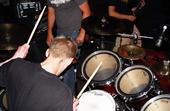Burn, Burn, Burn
In a time of advanced computer technology, most of us have access to a CD burner. Although many still routinely purchase albums from record stores, many more have turned to their computers to make their own discs. Using common software, one can make their own mix CDs or make exact copies of any record in a collection.
For Conscender, however, the CD burner has become an item associated with painstakingly mundane work that now occupies a large portion of their practice time. After recently recording a three track demo, the band is now in the process of producing hundreds of copies for distribution to fans and for their press kit that will be sent to record labels.
Armed with an older model Sony desktop computer and a stack of blank discs, the band’s members repeatedly load each CD and click the burn button in the browser of Windows Media Player. As each new copy emerges warm from the hard drive, a designated member slaps on a printed circular sticker label that contains band info and slides it into a paper CD envelope. These envelopes are loaded into a cardboard box to be taken to shows and handed out to anyone who will take one.

Conscender hopes that the demos will help expand their fan base and gain some label attention. By self producing the CDs and circulating them free of cost, the band hopes that people will be willing to listen to their music and attend their shows. By not relying on Oasis Manufacturing (the same company that pressed their previous 2 records), Conscender will try to preserve the band bank account to pay for other needs such as equipment, merchandise, and gas for traveling.
Pressing at Oasis typically runs around $1,400 for 1,000 jewel case CDs with 4 panel inserts. On the contrary, the band can purchase blank discs for around $35 per hundred and completely cut out labor costs. The labels are also printed by the band and are relatively inexpensive.
A band with a deal would have no such struggle to get their music out. The label would take responsibility for all manufacturing and distribution and also front all the cost to be later recouped through sales. Until the day comes that Conscender sees such a contract, they will go on and continue their assembly line until the computer's burner is burned out.
For Conscender, however, the CD burner has become an item associated with painstakingly mundane work that now occupies a large portion of their practice time. After recently recording a three track demo, the band is now in the process of producing hundreds of copies for distribution to fans and for their press kit that will be sent to record labels.
Armed with an older model Sony desktop computer and a stack of blank discs, the band’s members repeatedly load each CD and click the burn button in the browser of Windows Media Player. As each new copy emerges warm from the hard drive, a designated member slaps on a printed circular sticker label that contains band info and slides it into a paper CD envelope. These envelopes are loaded into a cardboard box to be taken to shows and handed out to anyone who will take one.

Conscender hopes that the demos will help expand their fan base and gain some label attention. By self producing the CDs and circulating them free of cost, the band hopes that people will be willing to listen to their music and attend their shows. By not relying on Oasis Manufacturing (the same company that pressed their previous 2 records), Conscender will try to preserve the band bank account to pay for other needs such as equipment, merchandise, and gas for traveling.
Pressing at Oasis typically runs around $1,400 for 1,000 jewel case CDs with 4 panel inserts. On the contrary, the band can purchase blank discs for around $35 per hundred and completely cut out labor costs. The labels are also printed by the band and are relatively inexpensive.
A band with a deal would have no such struggle to get their music out. The label would take responsibility for all manufacturing and distribution and also front all the cost to be later recouped through sales. Until the day comes that Conscender sees such a contract, they will go on and continue their assembly line until the computer's burner is burned out.




